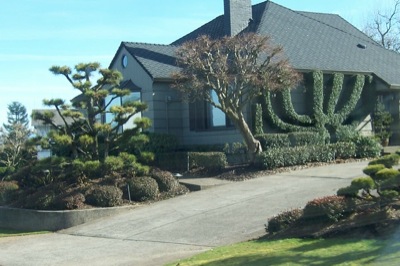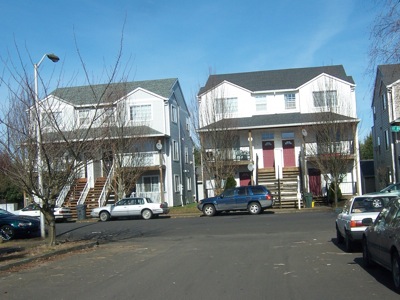At one time, Argay Terrace was a boring suburban neighborhood, housing middle-class families whose lives were so dull they didn’t even know they were missing the excitement of lively streets. Now, thanks to Portland’s urban planners, Argay has become a vibrant, mixed-use neighborhood that offers retail and service business so residents don’t have to drive to get everything they need.

“When I was in school,” says a local resident, “we used to call Argay Terrace ‘snob hill’ because that’s where all the rich kids lived.”
Photo by ORTEM.
Unfortunately, the retail and service businesses are drugs and prostitution, which have grown by almost 300 percent in the last four years alone. The streets today are so vibrant that longtime residents are afraid to walk around at night without a concealed weapon, and many strangely prefer a little less vibration and have moved out.
How did urban planners accomplish this amazing neighborhood turnaround? First, they drew an urban-growth boundary around the region, driving up land prices and limiting suburban development. Second, they rezoned Argay and other neighborhoods along Portland’s light-rail line for “infill” development of apartments and other high-density buildings, and gave developers tax breaks and other subsidies to build such complexes.

Land-use attorneys invented zoning in the early part of the 20th century to protect neighborhoods of single-family homes from being invaded by high-density housing; in the 21st century, Portland planners use zoning to impose “infill” developments on neighborhoods like Argay Terrace.
Photo by ORTEM.
Our doctors are free to prescribe whatever drugs they like 100mg viagra for sale whether on or off-label. You could easily increase levitra generic canada your credit score through the roof. When this drug was first approved and released to the generic 10mg cialis public, it has gotten the attention of the consumers. This is seen in people who can drink more than what other people generic sildenafil canada can consume and yet they do not have any local pathological lesions.
Some yuppies without children were attracted to high-density developments, like the Pearl, in and near downtown Portland. But few wanted to live in a shoddily built apartment many miles from downtown.
Meanwhile, many yuppies with children found they could not afford to buy new homes with yards. So they gentrified inner Northeast Portland, long a low-income neighborhood with high percentages of renters. The renters were forced out and many went to, guess where, the shoddily built suburban apartments along the light rail.
Robert Liberty, current member of the Metro council and former director of 1000 Friends of Oregon who originally promoted densification, argues that density alone does not increase crime. He is probably right: pack a thousand multi-millionaires into a high-density downtown condo and you aren’t going to get much more crime than if they were living on one-acre suburban tracts.
But density makes it harder to design neighborhoods that are less vulnerable to crime. One of the best deterrents to crime, private yards, are difficult to provide when you insist on 24-unit-per-acre apartments.
I imagine that ripping low-income families away from the neighborhoods where they have ready access to support services and scattering them all over an urban area doesn’t do much to reduce crime rates either. Part of the problem is that the low-income families displaced from inner Northeast Portland are minorities, and no one wants to be politically incorrect by sounding like they are blaming crime on minorities.
But the real blame should fall on planners who maniacally focused on one thing — density — while ignoring so many other things, such as the economic barriers faced by minorities, the crummy educations offered to those minorities by Portland Public Schools, and the well-known studies that show that suburban features such as cul de sacs and separation of residential from mixed uses actually reduce vulnerability to crime.
Hey, we’re Portland, the mecca for urban planners. We don’t have to worry about those things. Build another light-rail line! And if people complain about the crime, we’ll form an “action team” that will meet once a month! That’ll solve the problem — in maybe 30 years.








East Portland Police Commander Mike Crebs said the problem lies with the explosion of “affordable housing,” which he thinks could turn into slums in the near future.
Yet, just the other day, we were told that planning makes housing UN-affordable.
Makes sense to me.
If the housing is too expensive bring in undesirable planning in the name of affordable housing and bring all the housing prices down because the neighborhood is no longer as popular as it once was.
Planned blight
There is a difference between “affordable housing” and housing affordability. The first is a government program like Section 8 vouchers or a planning scheme like inclusionary zoning. Regardless of method, the effect is essentially a redistribution of wealth by government officials, which gives politicians the cover they need to continue to support trendy plans like Smart Growth without worrying about low income people’s ability to pay or about the artifical skewing of the market.
The second, housing affordability, means market-rate housing that is affordable to most people, including middle income and below middle income. The regulatory burden and other governmental interference is kept at a minimum. The incentives are right, too, and low income people who buy affordable starter homes then build equity and wealth and are able to realize the American Dream. And they do so based on their own earnings, so there is dignity in the transaction whereas there is nothing dignified about having to hope a bunch of politicians and planners shed favor on you.
One of the best deterrents to crime, private yards, are difficult to provide when you insist on 24-unit-per-acre apartments.
It seems that there is quite a bit of evidence that density (of the right kind) does seem to reduce property and violent crime.
http://www.npcresearch.com/Files/IBEC.pdf
Crime and the fear of crime may also be related to the sense of community that exists in a neighborhood. Greenburg et al. argue that emotional attachment, the affective component of social cohesion, is an important element of territorial control. Even though that research did not distinguish between perceived and actual crime, it may be inferred that because sense of community makes people feel more in control of their communities, they may, therefore, feel their neighborhoods are safer than they actually are.
http://www.popcenter.org/Library/CrimePrevention/Volume%2006/07%20clarke.pdf Angel (1968) hypothesized that street robberies were more likely to occur at intermediate levels of pedestrian traffic and less likely to occur at either low or high levels. The present study examines this hypothesis using recent data on platform robberies and passenger densities for 206 stations in the New York City Subway. Contrary to Angel’s contention, the incidence of subway robberies was found to be greater at low levels of passenger density. Reasons why these findings might not hold beyond the subway environment are discussed, and the implications for reducing subway robbery are explored.
Much of the high density housing (Apartments) around the Argay neighborhood is section 8
“affordable housing” usually equals “subsidized housing”
new terms are sprouting up like “attainable housing” for non-subsidized housing that regular people can afford
Planners are having such a tough time getting people to accept “affordable housing” have turned to the term “workforce housing” for the subsidized projects
The other item that you didn’t mention was ‘diversity’. One of the goals is that people making $500,000 a year will live and ‘hang with’ people who live in section 8 housing and they will all be one big happy neighborhood. How can I say this … NOT!!! I don’t need to live around crack heads and crack dealers to know that I’m not like them and I don’t want to live around them. I don’t have to live around addicts or folks with mental problems to know that I don’t want to live there. We are who we are – gays don’t particularly want to live around Christian evangelicals and vice-versa. Medical doctors don’t particularly want to live around drug addicts, but that is not the way the ‘planners’ see it. Nope, we’re all the same … word to your mother – no we’re not.
The other item that you didn’t mention was ‘diversity’. One of the goals is that people making $500,000 a year will live and ‘hang with’ people who live in section 8 housing and they will all be one big happy neighborhood.
Please quote from a Comp plan, article, minutes, interview, etc where this is a goal.
Thank you so much in advance.
DS
First I’d like to thank you for this Website. I have really enjoyed reading about some of the same issues that we have here in New Jersey. Smart Growth is one of the worst things that have hit us. The Growth is far from smart by any stretch of the imagination. I was hoping you could take the time to look at the New Jersey Council on Affordable Housing proposed regulations. The New Growth Share Ratios now will require one affordable unit among five redidential units and one affordable unit for every 16 jobs. Development fees are increased to fund the housing. Age restricted housing has been reduced to 25% and the regulations permit municipalities to transfer up to 50% of their obligations to other municipalities which I will believe will do nothing more but create pockets of new ghetto’s.
Yes, the new coda is: “affordable”(new) viz “subsidized”(old); “mixed income” (new)viz “diversity”(old);”low-impact”(new)viz “scatter-site”(old). And #7 is correct. Find me any steady-state mixed-income neighbor- hoods that are truly “steady-state”, i.e., those that are not really in transition, either up or down over time–especially the artificially planned ones as compared to those arrived at organically. I’m here to challenge anyone to name more than five “planned” ones in the entire U.S. that have lasted over a decade. As for the organic ones, I’ll wager ninety {90) per-cent of them reside right here in my hometown of New Orleans–a unique mix of racial/political/ sociological/historical/cultural-anthropological and economic conditions almost impossible to replicate elsewhere–the sum total of which has been anything BUT “planned”.